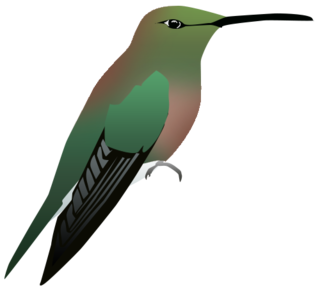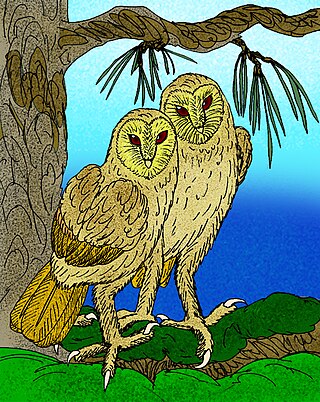
Nightjars are medium-sized nocturnal or crepuscular birds in the family Caprimulgidae and order Caprimulgiformes, characterised by long wings, short legs, and very short bills. They are sometimes called bugeaters, their primary source of food being insects. Some New World species are called nighthawks. The English word nightjar originally referred to the European nightjar.

The oilbird, locally known as the guácharo, is a bird species found in the northern areas of South America including the Caribbean island of Trinidad. It is the only species in the genus Steatornis, the family Steatornithidae, and the order Steatornithiformes. Nesting in colonies in caves, oilbirds are nocturnal feeders on the fruits of the oil palm and tropical laurels. They are the only nocturnal flying fruit-eating birds in the world. They forage at night, with specially adapted eyesight. However, they navigate by echolocation in the same way as bats, one of the few birds to do so. They produce a high-pitched clicking sound of around 2 kHz that is audible to humans.

The St. Croix macaw or Puerto Rican macaw is an extinct species of macaw whose remains have been found on the Caribbean islands of St. Croix and Puerto Rico. It was described in 1937 based on a tibiotarsus leg bone unearthed from a kitchen midden at a pre-Columbian site on St. Croix. A second specimen consisting of various bones from a similar site on Puerto Rico was described in 2008, while a coracoid from Montserrat may belong to this or another extinct species of macaw. The St. Croix macaw is one of 13 extinct macaw species that have been proposed to have lived on the Caribbean islands. Macaws were frequently transported long distances by humans in prehistoric and historical times, so it is impossible to know whether species known only from bones or accounts were native or imported.

The Cuban macaw or Cuban red macaw is an extinct species of macaw native to the main island of Cuba and the nearby Isla de la Juventud. It became extinct in the late 19th century. Its relationship with other macaws in its genus was long uncertain, but it was thought to have been closely related to the scarlet macaw, which has some similarities in appearance. It may also have been closely related, or identical, to the hypothetical Jamaican red macaw. A 2018 DNA study found that it was the sister species of two red and two green species of extant macaws.

Brace's emerald is an extinct species of hummingbird which was endemic to the main island of the Bahamas, New Providence.

Tyto pollens is an extinct giant barn owl which lived in the Bahamas during the last Ice Age.

The New Zealand owlet-nightjar, is an extinct bird species that was formerly endemic to New Zealand. It is recognized as the largest known species within the family Aegothelidae (owlet-nightjars). In Māori, the indigenous language of New Zealand, it is called Ruru hinapō. This species is characterized by its enlarged body size, reduced wings, and strong legs. It is believed to have been either flightless or had very minimal flight ability. The New Zealand owlet-nightjar went extinct in the late 13th century, prior to significant human settlement in New Zealand. Consequently, little is known about its plumage, breeding habits, or behavior; most available information regarding its morphology and behavior is derived from remnants, bones, and DNA analysis.

The genus Cathartes includes medium-sized to large carrion-feeding birds in the New World vulture (Cathartidae) family. The three extant species currently classified in this genus occur widely in the Americas. There is one extinct species known from the Quaternary of Cuba.

Siphonorhis is a genus of nightjars, known as the Caribbean pauraques, in the family Caprimulgidae.
Buteogallus borrasi is a species of giant buteonine hawk which went extinct in the early Holocene. Formerly endemic to Cuba, this huge bird of prey probably fed on Pleistocene megafauna. Little is known about its appearance and ecology, so no common name has been given.

The great Maui crake or great Maui rail is an extinct bird species from Maui, Hawaiian Islands, known only from subfossil bones. The holotype are the bones of one almost-complete skeleton, found in Auwahi Cave on the lower southern slope of Haleakalā at 1,145 m AMSL. Its first remains, however, were recovered in 1972 and/or 1974 from lower Waihoi Valley further east and less than half as far uphill.
The pile-builder megapode is an extinct species of megapode. The subfossil remains were found by Jean-Christophe Balouet and Storrs L. Olson in the Pindai Caves of New Caledonia. Its remains have also been found on Tonga.
Paleontology or palaeontology is the study of prehistoric life forms on Earth through the examination of plant and animal fossils. This includes the study of body fossils, tracks (ichnites), burrows, cast-off parts, fossilised feces (coprolites), palynomorphs and chemical residues. Because humans have encountered fossils for millennia, paleontology has a long history both before and after becoming formalized as a science. This article records significant discoveries and events related to paleontology that occurred or were published in the year 1985.
Titanohierax gloveralleni, also known as the Bahama eagle, is a large species of extinct hawk from the Late Quaternary of the Caribbean. Remains of the animal have been found on multiple islands in The Bahamas. The animal is known from a handful of bones found across multiple islands, including a tarsometatarsus, partial metacarpal, and nearly complete right ulna. The animal was described based on the former two by Alexander Wetmore in 1937, with all other currently referred material being assigned by Storrs Olson and colleagues in 1982.

The Jamaican ibis, Jamaican flightless ibis or clubbed-wing ibis is an extinct bird species of the ibis subfamily uniquely characterized by its club-like wings. It is the only species in the genus Xenicibis, and one of only two flightless ibis genera, the other being the genus Apteribis which was endemic to Hawaii's islands of Maui Nui.
Long Mile Cave, sometimes known locally as Pick'ny Mama Cave or Hell's Gate Cave, is a palaeontological and palaeoanthropological site in the Cockpit Country of north-western Jamaica.
Gymnogyps varonai, sometimes called the Cuban condor, is an extinct species of large New World vulture in the family Cathartidae. G. varonai is related to the living California condor, G. californianus and the extinct G. kofordi, either one of which it may have evolved from. The species is solely known from fossils found in the late Pleistocene to early Holocene tar seep deposits in Cuba. G. varonai may have preyed upon carcasses from large mammals such as ground sloths.
Bubo osvaldoi, also known as the Cuban horned owl, is an extinct species of horned owl from the Pleistocene of Cuba.
Emslie's vulture is an extinct species of vulture in the family Cathartidae. It is only known from a series of fossils found in western Cuba. The fossils were primarily found in caves or Quaternary asphalt deposits. It is significantly smaller than the extant C. aura. It likely became extinct during the Holocene following the extinction of Cuban Pleistocene megafauna whose bodies it would have fed on, coupled with the loss of the open savannas it would have inhabited.










